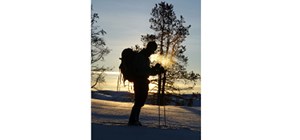Last updated: March 8, 2025
Article
How Dry Will Parks Get? Water Deficit Tells Us
Dryness has an outsized impact on nature in parks, but temperature and precipitation are poor indicators.
By David P. Thoma, John E. Gross, Michael T. Tercek, and Janelle N. Christensen

Image credit: NPS / David Thoma
The expression “water is life” is rich with meaning in national parks. When you visit a national park, you expect to see and experience unaltered native landscapes, maybe with a waterfall or a lake. But in addition to adding richness to the scenery, water plays a critical role in park ecology. The timing and amount of water controls the geographic distribution of plants and animals. If the amount of water decreases over time, the life that depends on it will change too. A forest might transition to a grassland, or a grassland might transition to a shrubland. How can we track changes in water to understand how climate change might affect parks?
In our research on water abundance, movement, and shortfalls in national parks, we found that dryness, an indicator of drought stress, has acute effects on natural resources. To our surprise, these effects were often much stronger than the effects of precipitation. We found that vegetation production, forest disease, stream flow, and wildfire were very sensitive to dryness. Considering our own need for water, maybe this shouldn’t be a surprise. Quantifying dryness and sensitivity to dryness in parks is challenging, but it is evolving through the use of new tools and data sources.
The Challenge of Quantifying Dryness
Understanding the consequences of dryness is important. This is because many parks, especially those in the West, are experiencing rapid climate change from anthropogenic warming. These parks are now hotter and drier than they were in the recent past. Climate projections tell us how much warming or precipitation may occur in the future. But temperature and precipitation are poor indicators of dryness, because they interact. The effects of temperature can overwhelm the ability of more precipitation to alleviate dry conditions. This has consequences in eastern parks too, because warmer temperatures in dry years can dramatically increase dryness.
Consider a grassland in northern Yellowstone that supports elk, bison, and pronghorn. Suppose annual precipitation there is five inches above average, and temperature is three degrees above average. From the perspective of plants, is this year drier or wetter than average? You can’t answer this question just from temperature and precipitation. But using a mathematical model of water balance, we estimate that it is 17 percent drier than average for plants. This is important if you want to know what might happen to plants and grazing animals—who depend on plants—in Yellowstone.
What if the future brings more dry years like this? Results from global climate models include a range of projected changes in precipitation and temperature. We can use these climate projections in our water balance model and tell park managers unequivocally whether the projections are for a park to be wetter or drier and by how much. This helps them understand how natural resources will respond to climate change. What park managers do with this information depends on their management goals and whether they chose to “resist, accept, or direct” inevitable ecological transitions. But the first step is knowing whether the future is likely to be drier and by how much.
Challenging “Aspects”
Let’s look at a mountain ridge where both sides have the same precipitation, but the north side is forested, and the south side is a grassland. It is impossible to say how changes in precipitation or temperature will affect these habitats without considering slope, aspect, and the ability of the soil to hold water. These factors affect dryness in ways that are not captured by basic temperature and precipitation measurements. In this case, grasses and shrubs growing on the south side can tolerate higher levels of dryness than trees growing on the north side. This tells us that grasses and shrubs are adapted to handle drier conditions than forests in this setting.

Image credit: NPS / David Thoma
What about dry conditions that are not extreme but cause chronic stress on plants and animals as the climate changes? These are conditions that can “sneak up” on managers. We have developed tools that estimate changes in dryness to help avoid surprises. Our tools help managers answer questions like whether to implement fire restrictions or elevate preparedness levels, whether it’s a good year to restore native vegetation, or whether fish in streams are likely to be stressed. Answering those questions with only temperature and precipitation measurements may lead to incorrect conclusions, wasted resources, and lost opportunities. This is because temperature and precipitation don’t accurately reflect the dryness experienced by plants and animals.
A Better Indicator
Evapotranspiration returns water to the atmosphere through evaporation and transpiration, which is water movement through plants. When soils dry sufficiently to limit evapotranspiration, a climatic water deficit occurs. Water deficit is the additional amount of water plants could use if it were available. Site conditions, like how much water the soil can hold and which way a hill slope faces, modify the effects of precipitation and temperature. We need to account for all these interacting factors that vary at local scales when determining dryness in parks. When we estimate water deficit, we incorporate these interactions into a single variable. We do this using a water balance model that describes the movement of water in nature.
Water deficit tells us when nature gets thirsty by estimating how much additional water plants need. When water deficit is outside the normal range of plant adaptations, it restricts plant growth and other ecological processes. Water deficit is estimated as inches of additional water need. Therefore, farmers and golf course managers can use it to determine how much and when to irrigate. With few exceptions, park managers don’t irrigate park lands, but knowing how stressed nature is during a drought gives them the information they need to evaluate their options.
Water deficit calculations show that the climate in some places has recently changed so much that it is outside the range needed for tree regeneration after fires. If a hillside burns, should a manager replant trees or grasses, or leave it alone? We need accurate estimates of dryness to answer that question.
In the process of estimating water deficit, we also estimate many other important water-related variables. Ecologists from the National Park Service’s inventory and monitoring program have used some of these other variables to better understand amphibian populations in Grand Teton National Park and spring flow in Arches National Park. Indeed, there are as many applications for this information as there are plant and animal species that depend on water.

Image credit: NPS / David Thoma
Will the Climate Get Drier in All Parks?
We recently found that most western parks are becoming drier, and most eastern parks are getting wetter. This has altered how much water is available for people and plants. Projections show that human-caused climate changes are expected to strengthen these dry and wet trends well into the future. But even in historically wet places, episodic drought is inevitable.
When Wet Places Get Dry
Even typically wet places experience drought, with unusually detrimental consequences for species adapted to moderately wet conditions but less suited for dry ones. Consistent precipitation and fog in Great Smoky Mountains National Park make it a wet environment that supports remarkably high biodiversity. But a warm fall drought in 2016 made vegetation flammable enough that a late November wildfire burned 11,000 acres of the park. The current (November 2021) drought in Maine will need more than a foot of rain to quench. Increases in water deficit can be an early warning of persistent dry conditions. Real-time estimates of water deficit, using our mathematical tools, can help park managers monitor drought conditions as they unfold in historically wet places.
The importance of water deficit is well known to Craig Allen, a retired U.S. Geological Survey ecologist in New Mexico. He specializes in the effects of drought and fire on forests and offers this warning:
Every place has dry years, so even wet places will have dry years that, with ongoing global warming, will become ever more stressful. Dry places like the southwest U.S. provide a cautionary warning of what the future holds for wetter places. They show the growing risks of novel surprises that have the potential to irreversibly change ecosystems. So, coming soon to a landscape near you, expect the emergence of forest dieback from hotter drought.
In our studies, we’ve seen that the wettest parts of the landscape are the most sensitive to water deficit. We found significant variations in water deficits from one year to the next in normally wet or moist habitats in Yellowstone, like meadows and alpine grasslands. Our observations suggest that high water deficits, which indicate unusually dry conditions, can occur in almost any habitat. Because of the outsized impacts on species adapted to wet conditions, climate change that drives greater water deficit in wet places deserves extra attention.
When Dry Places Get Drier
Plants respond dramatically to variation in precipitation in semiarid national parks like Capitol Reef. But as Dr. Allen noted, warming will increase dryness even if precipitation remains constant. We cannot accurately describe this change in dryness experienced by plants using precipitation. That requires an understanding of water deficit.
Over the past 20 years, the National Park Service’s inventory and monitoring program has measured vegetation response to water deficit and determined that plants have largely rebounded after episodic dry spells. But as the west becomes more arid and water deficits become larger, the opportunities for rebound become less frequent. This makes the decline or loss of some native plant species inevitable. Even slight changes in dryness can alter plant and bird communities in arid environments, making water deficit an important variable to track.
Other Estimates of Dryness
Despite the utility of water deficit in our studies, it may not be the best indicator of dryness for all applications. Wildland fire management programs routinely estimate dryness using fuel moisture and the Keetch-Byram Drought Index. These are related to fire danger, and managers have used them for years. Other drought metrics are available, but they are reported as an index rather than in inches of water like water deficit. And few of them account for hill slope aspect or soil properties. They are therefore more difficult to understand or to interpret at local scales. Nevertheless, like water deficit, all these dryness indicators are better than temperature and precipitation. But water deficit has advantages that we think are especially useful for park managers.
Our studies demonstrate that water deficit is a good indicator of dryness at scales relevant to park managers, and it is broadly applicable to many park resources. Despite the demonstrated utility of water deficit for assessing the condition of park resources, it’s underused by managers. This is in part because it has not been readily available. Before the development of our new tools and data sources, managers needed to calculate it on their own or obtain it from other agencies or sources.
Evaluating Vulnerability
Our studies of water deficit clearly show that national parks need to prepare for very different climate futures to manage their resources effectively. We use monitoring data, climate projections, and climate smart conservation planning to determine what park resources may experience in the future. In many parks, conditions now considered extreme are likely to occur more often. An essential first step in assessing climate vulnerability is to identify the climate variable to which a species or resource is most sensitive.

Image credit: NPS / Janelle Christensen
Our research in western parks determined the amount of water deficit that plants can tolerate, which is the key to understanding how changes in dryness may affect them in the future. A vulnerability assessment of this kind helps managers anticipate and plan for change. We have also developed tools to help park managers determine if they need to intervene now. For example, we report levels of vegetation stress and wildfire danger using water deficit in real time. This can help managers determine where, when, and what actions to take.
Water deficit is an important ecological indicator in both wet and dry places and provides insights regarding potential impacts. Using water deficit, we can estimate dryness with the temporal and spatial specificity that park managers need. Water deficit is an integrative measure with an intuitive relationship to plant water needs. This makes it useful for evaluating dryness-related vulnerabilities.
Addressing the Need
We have made water deficit data available for the entire continental U.S. We estimated water balance variables (including water deficit) daily from 1980 to 2100 for many climate scenarios. We did this by modeling the historic and future water balance. We also developed tools to calculate water deficit and other water balance variables using weather station data and other freely available climate data sets for local applications. Now, if park managers want to know—and plan for—how dry their park is going to get, water deficit can help them.
About the authors

David Thoma is an ecologist with the NPS Northern Colorado Plateau Inventory & Monitoring Network and Greater Yellowstone Inventory & Monitoring Network. David uses vital signs monitoring data and a water balance model to describe how nature responds to weather and climate in parks. This helps managers understand how climate change may affect parks and which actions can help minimize undesirable effects. With his colleagues, David has published on water availability and drought effects that can help guide conservation of desert springs, semiarid rangelands, montane wetlands, subalpine forests, and alpine meadows. Image courtesy of David Thoma.

John Gross is an ecologist with the NPS Climate Change Response Program. He helps parks understand and adapt to the ongoing challenges of climate change. Image courtesy of John Gross.

Michael Tercek is the founder of Walking Shadow Ecology and lives in Gardiner, Montana, which is the north entrance to Yellowstone National Park. Image courtesy of Michael Tercek.

Janelle Christensen is currently working for the U.S.Department of Agriculture's Northwest Climate Hub as a climate change communications fellow. She holds a Masters of Environmental Science and Management from University of California Santa Barbara’s Bren School of Environmental Science and Management. There, she studied environmental communications and water resource management. She also worked for the National Park Service as a Scientists-in-Parks Fellow. Prior to her graduate degree, she worked with farmers in Senegal, West Africa as a Peace Corps volunteer to find and implement solutions to deforestation. Image © Janelle Christensen.
